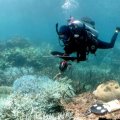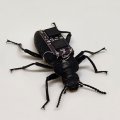Mention the word 'shark' and most people think 'Jaws', Steven Spielberg, shark attacks, and the need to vacate the water rather quickly.
But for University of Queensland PhD student Michelle Heupel, close encounters with sharks are a regular hands-on activity.
In the shallow water near the University of Queensland's Heron Island Research Station, she snares a small black-tip reef shark or an epaulette shark with a net or grabs them islander-style with her bare hands. Then she studies them, to improve knowledge of their biology and habits.
This information could also prove useful for fisheries management and reef conservation efforts.
The epaulette shark is flexible enough to bite its own tail and Ms Heupel has to carefully position her fingers to ensure she still has 10 digits at the end of the day.
She has felt the small teeth aligned to grinding plates clamp onto her arm and twist in a strong pinch - but serious injury was avoided.
Despite half a dozen other minor nips in the past four years, Ms Heupel is a strong advocate of sharks, primitive fish found at all depths of coastal and open-ocean waters. The 300 known species have teeth, but only 25 to 40 species are considered potentially dangerous to human swimmers.
Sharks were basically benign and more likely to damage other fish than attempt human prey, she said.
'Interactions between sharks and humans are infrequent and rarely result in human injury,' she said.
'Heron Island has seen only one negative interaction in the past 25 years when several years ago a British tourist suffered puncture wounds to her arm, then the shark disengaged and swam off. It was probably an accident. If the shark had serious intentions, it wouldn't have stopped there.'
Ms Heupel is studying the biology of both the epaulette (Hemicyllium ocellatum) and the black-tip reef shark (Carcharhinus melanopterus), two timid species found near the University's Heron Island Research Station, about 80km from Gladstone.
The epaulette shark grows to about a metre long, has trademark black spots which earn its name, and feeds on bottom-dwelling small crabs, shrimps, and worms.
It has an interesting mating strategy. Male epaulettes bite the females' fins, and hold on tight, trying to roll females over while inserting clampers to fertilise them.
The species hides in coral most of the day, and often at night, highly camouflaged to avoid the attentions of large sharks and predatory sea birds.
Black-tip sharks grow to 1.5 metres and mainly eat fish. They are exceptionally timid and exit quickly at the sight of human divers.
Both species were discovered in the 1800s, but until now, almost nothing was known about them.
'Although their distribution was known, no one had any idea about their impact on reefs, the size of their populations, and their rates of growth,' Ms Heupel said.
'My research has also examined breeding seasons, the size or age they are mature enough to breed, their reproductive biology, the parasitic fauna they support, their diet, whether they are nocturnal or diurnal creatures, and even how long they live.'
Fish are weighed and tagged, blood samples taken and acoustic telemetry used to determine periods of activity and inactivity in both species and how far the fish move each day.
The project is supervised by Dr Mike Bennett and Dr Joan Whittier of the Anatomical Sciences Department.
Pulling heavy nets in Shark Bay at Heron Island is a long-way from the land-locked Rocky Mountains in Colorado where Ms Heupel grew up, with a love for marine creatures she had seen only in books. She wanted to be a marine biologist from age 13 but saw the ocean for the first time as a 15-year-old.
After completing a bachelor of zoology at Colorado State University in 1994, she embraced the chance to study sharks in northern Australia's coral reefs. Ms Heupel undertook a postgraduate science diploma at the University of Queensland in 1995, honing her telemetry skills by assisting with radio-tracking of bridled nail-tailed wallabies at Dingo, west of Rockhampton.
She has been funded by a University of Queensland postgraduate research scholarship, an Overseas Postgraduate Research Scholarship, and received a University of Queensland Alumni Association postgraduate bursary in 1995. Grants from the Great Barrier Reef Marine Parks Authority and the Australian Coral Reef Society have helped her research.
Ms Heupel said the hardest part was waking in the middle of the night to collect, examine and release animals.
'You do become nocturnal but unfortunately tides shift one hour each day so your body never really gets into a rhythm,' she said.
'I can't think of anything I'd rather do. Every time I'm reef walking or snorkelling, I see something new.'
For further information, contact Ms Heupel, telephone 07 3365 2961, email: s119596@student.uq.edu.au
.jpg)


